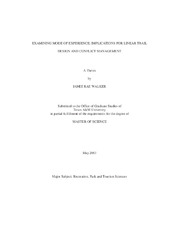| dc.description.abstract | Jacob and Schreyer (1980) define mode of experience (e.g. the degree to which participants experience an environment as focused or unfocused) as one of four major factors underlying outdoor recreation conflict. To discover the degree to which mountain bikers and hikers focus in the environment and to identify the key environmental elements and cognitive processes relevant to creating the mode of experience and underlying conflict, Visitor Employed Photography, VEP, and follow-up interviews were combined to explore mountain bikers' and hikers' perceptual experiences.
Twelve mountain bikers (7 males, 5 females) rode about four and one half miles of the Lake Bryan East Loop Trail and 12 hikers (6 males, 6 females) hiked about 1.5 miles. Each participant was given a digital camera and tape recorder and was instructed to stop and take a picture of whatever they were looking at right when they heard music play.
Findings indicate that mountain bikers tended to concentrate on Trail Corridor elements while forming or creating their Path/Line to travel while hikers tended to look around, scan, or take in full views of Wildlife, Vegetation, and Noises.
Combined analyses suggested that mountain bikers photographed On-Trail Tread-Specific and Path/Line perceptions while hikers photographed Off/Off Distant-Views of Vegetation and Noises. Consensus existed among both for photographing On Distant at Trail Corridor elements down the Path/Line; On Distant at Trail Corridor elements Panoramic Forward; and at the Edge of Specific Vegetation elements.
Interview findings indicated that participants rely on complex cognitive processes that involve focusing on many areas of the trail at one time. The participant's cue formation processes, foreground/background formation, goals, sequencing, and dynamic movement influenced their mode of experience.
Using the findings, this paper presents a graphic representation of mode of experience accounting for the changes participants experience; discusses lingering appraisals' affects on participants' future perceptions during linear trail experiences; discusses conflict mitigation using trail design techniques; provides design suggestions for diminishing hiker and mountain biker conflicts; suggests an adapted ROS, Recreation Opportunity Spectrum, to manage trails for setting based outcomes from a mode of experience perspective; and discusses integrating user participation in management decisions. | en |


